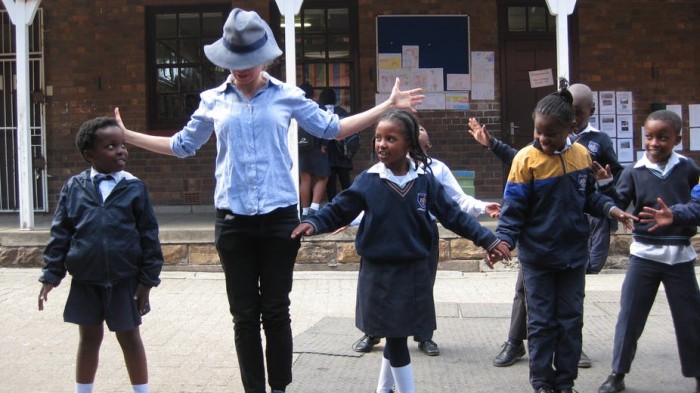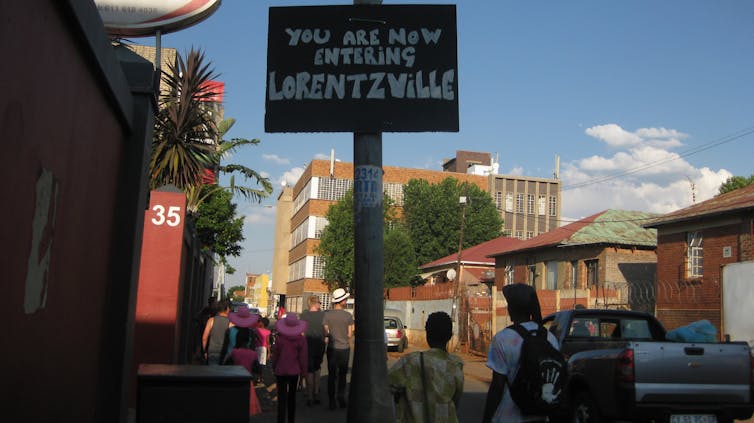
What gives an urban area a particular quality? What is the mood, feeling or atmosphere that makes a “place”?
At a superficial glance city spaces might seem defined by road layouts and buildings, infrastructure and zoning laws. But my interest as a researcher and theatre maker is in investigating the kinds of everyday interactions that give these spaces an identity – that make them places.
That’s why, over a 13-month period from late 2015 to late 2016, I ran a participatory arts project in three small suburbs in Johannesburg’s inner city. Collectively, the trio – Bertrams, Judith’s Paarl and Lorentzville – constitute the city’s second oldest suburban area.
They are clustered together colloquially as “Bertrams” (that’s the name I’ll use here) and are characterised by their mixed use, mixed demographics and active street life.
Anthropologist Tim Ingold has suggested that we make to know. In other words, making something allows us to learn about the people, place and materials we work with. I used this approach when I set out to make a play in Bertrams as a way of learning something of its daily placemaking activities: the routes people walk or drive, what they see and feel and do in the area.
For a year I worked with two institutions, Bertrams Junior School and Bienvenu Refugee Shelter for Women and Children. I ran weekly workshops that used storytelling and improvised games to reflect on the participants’ daily actions and experiences in their area. I volunteered at Bertrams Inner City Farm, a local organic market garden.
With my research assistant Baeletsi Tsatsi, I walked the grid of the area. We observed all we could sense and talked to people along the way. Eventually, all this work led to the creation of a play which took us as performers, Bertrams residents and outsiders on a journey through those same streets.
The play making was a tool for using bodies, voices and actions to find out about and reflect on the way people use their bodies, voices and actions daily to make city spaces into places. Theatre, when used in this way, offers an experiential engagement with daily acts of placemaking. This connects people’s hearts and minds more explicitly to the ways we live in concert with one another and our built environments.
Theatre beyond the stage
Taking theatre out of traditional theatre spaces and into the everyday world is a common practice globally So are art practices that invite everyday people to collaborate with professional artists in creating artworks. In recent years there has also been an increasing scholarly and artistic interest in the confluence of performance and cities.
Two South African examples relate to what I was trying to achieve with my PhD project. The first is a play called Ulwembu, made and first staged in Durban; the other is Cape Town’s Infecting the City, a public live art festival.
Ulwembu models the use of theatre as research tool. Its collective of academics, and professional and community theatre makers pooled their discipline-specific research tools to engage drug users, their families, and the police to make a play about the impact of the street drug nyaope in Durban.
Infecting the City places live performance work in public spaces throughout Cape Town to entice, provoke or gently engage city dwellers into a dialogue with their urban environment.
The key here is the making of art works to learn something about city worlds and then presenting them to the public – not to show concretised facts, but rather to continue the research exploration through the viewers’ experiences and responses to the artwork.
This is a valuable way to exchange knowledge. Performers and theatre makers share what they know, but also discover what they know through making the work. Audience members are drawn into a world where they learn experientially, but also contribute themselves through their presence.
Making a play
This approach guided Baeletsi and I from July 2016 when we started working with two other professional theatre makers, Lindiwe Mathsikiza and Toni Morkel, to shape a play that could reflect what we’d found over the preceding months.
We shared our experiences with them. They also attended the weekly workshops and did creative tasks to interact with Bertrams’ public spaces. In collaboration with each workshop group, we drew on participants’ everyday life experiences and actions to compose short performance pieces the participants would act in.
Then Baeletsi, Toni, Lindiwe and I structured a walking tour through the area, to be led by fictitious tour guide characters. Toni and Lindiwe played the tour guides in relays, capturing essences of people and ways of being and moving in their characterisations as they led the audience through the streets from performance piece to performance piece.

The final play was marketed to ticketed audiences from beyond Bertrams. But it also intentionally operated as public art to draw locals into watching and walking as the play progressed through the street. The play had two runs: one in August/September 2016 with 11 performances and one in November 2016 with 10 performances. A short documentary on the playmaking process was made and released in November 2018.
Taking the process further
My “making to know” continues in a small way in Bertrams through ongoing weekly workshops at Bienvenu Refugee Shelter. These are now facilitated by Market Theatre Laboratory and Wits School of the Arts students and recent graduates. There is much more to make – and much more to know.
![]()
Alex Halligey, Post-Doctoral Fellow with South African Research Chair in Spatial Analysis and City Planning, University of the Witwatersrand
This article is republished from The Conversation under a Creative Commons license. Read the original article.






